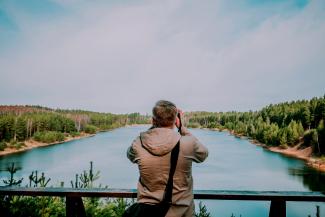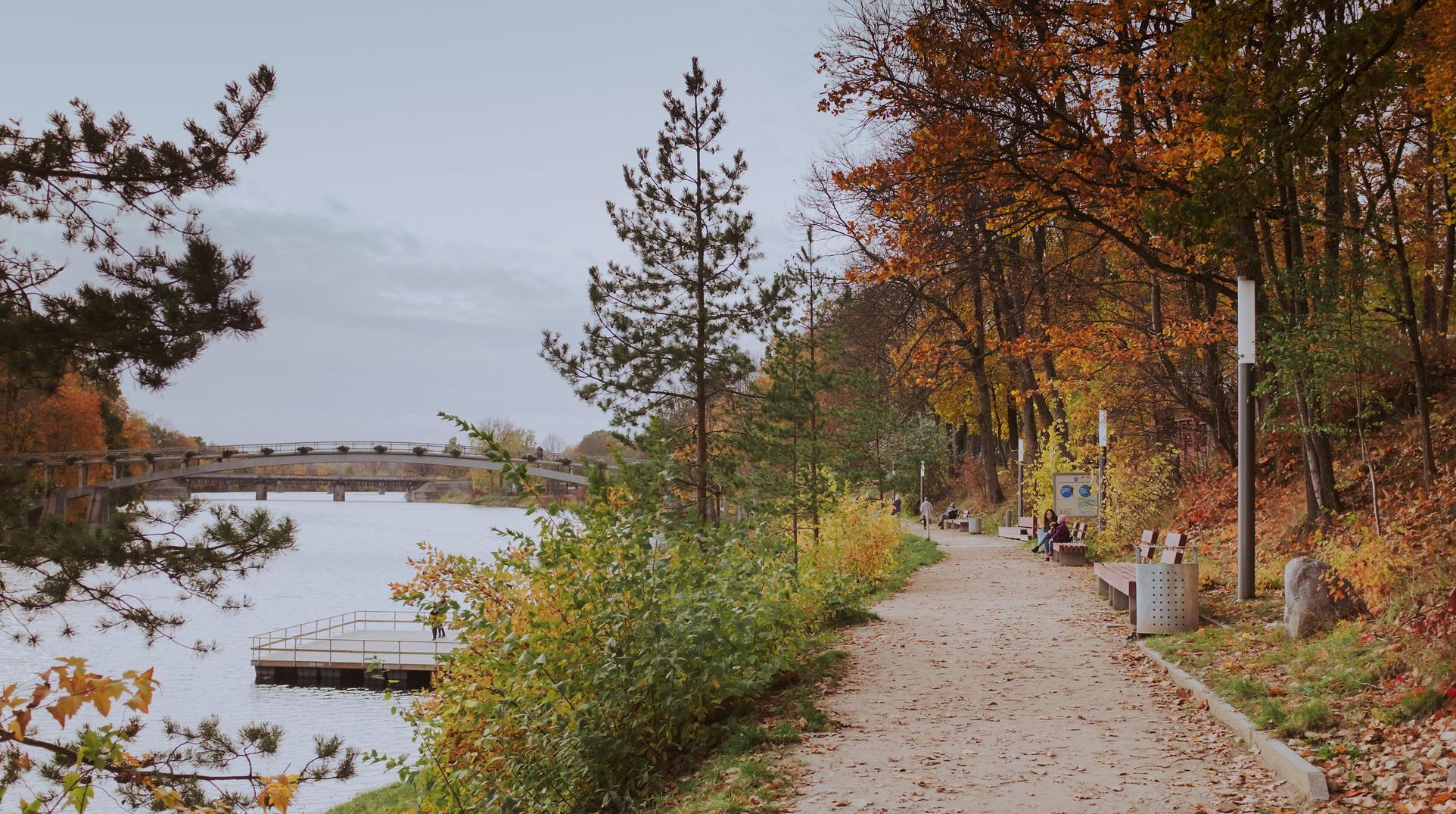Ogre is only 36 kilometres from Riga. It’s a state city offering a lot: nature, culture, history, and entertainment. The centre of Ogre is versatile and compact, and its surroundings are exciting. This is why Ogre is a particularly attractive day-trip destination. It’s very easy to get there from Riga - you can either take intercity buses or a train. If you choose public transportation, it will be more convenient to discover the city and its nearest attractions. However, if you get there by personal car (or perhaps a carsharing option), you will be able to inspect more of the nature and the nearest attraction spots around the city.
Ogre has a rich history - the region was already inhabited during the Iron Age. This is evidenced by the archaeological excavations at the Ķente Hillfort. Ogre was first mentioned in the Chronicle of Henry of Livonia, where the castles of ancestors have been described. It was named after the River Ogre. After the opening of the Riga-Daugavpils railway line in 1861 and taking into account the convenient traffic and beautiful nature, the city began to flourish into a resort and summer cottage district. When you take a stroll along the streets, you can notice numerous buildings that have been crafted as a romantic summer getaway cottage. However, during the USSR, the status of the city changed; it became more industrial, and today it has its own special character, combining the best of the city’s past and promoting growth for the future.

The centre of Ogre and sightseeing places nearby
Ogre is definitely a city where you can wander around aimlessly, observing its architecture, visiting local cafes and leisurely enjoying the day. However, to wholeheartedly take in the sightseeing, we suggest you include one of the stops listed below in your walkabout.
The River Ogre promenade
The renovated promenade stretches along the River Ogre for 2 km, offering a spectacular landscape following the flow of the river and its banks. The promenade begins at the footbridge over the river. The bridge was built in 1966 and it’s the largest arch bridge in Latvia. Since 2017, 100 m long wooden duckboards are being installed across the River Ogre, reviving the swimming resort atmosphere of Ogre of the 1920s and 30s. There was once a bridge across the river at approximately the same place. During the winter season the duckboards are dismantled.
Ogre Central Library
The Ogre Central Library building is an architectural gem in itself, once nominated for the Latvian Architecture Award. It is a sustainable and multifunctional building where local construction traditions meet state-of-the-art technologies. The new building of Ogre Central Library and Civil Registry Office is located on a wooded and hilly land plot at the end of a pedestrian street, which is the main axis of the historic Ogre. It is open to everyone and kindly welcomes all visitors. The library offers two electronic databases, 70 different titles of periodicals - newspapers and magazines - as well as information in catalogues, card files and subject folders and, of course, its extensive collection. Moreover, it’s a place where not only the grown-ups but also children can satisfy their curiosity.
Tower “OGRE”
Those who are carried away by more intense experiences, height and challenges should definitely check out the highest rock climbing tower in the Baltics “OGRE”. The 20 to 24 metre high rock climbing wall, built on an area of 1050 m2, is intended for training athletes, mountain tourists, mountain climbers and other enthusiasts. Next to the big wall, there is also a smaller bouldering wall of 2.5-4.5 metres (145 m2 in area) with routes for younger climbers. In addition, the climbing wall preserves evidence of history - a water tower built in the 20th century, which has now been given a new life.
The Digital Fountain
In the summer, in the square of Brīvības Street, next to the building of the cafe “Pie zelta liepas”, the residents and visitors of the city can enjoy the fountain complex “The Digital Water Curtain”, as well as the paddling pool, which is especially delightful for children. As the name suggests, the fountain is not ordinary - the digital water screen projects various visual characters and programmes adapted to decorations or specific events of the city. The fountain is particularly beautiful in the late hours of the day when colours, characters and signs are well visible. Before you decide to go and see the fountain for yourself, remember that it’s only operating during the warm season of the year.

Tourist attractions outside Ogre
On a day trip to Ogre, you can discover and see several interesting objects that characterise the culture and nature of the region. And it’s great that such objects can be explored by adventure seekers, those who love leisurely recreation, as well as families with children. However, it should be noted that a one-day trip will be more convenient with a personal car or using one of the carsharing services. Read more about the availability and options of these services here.
Nature park Ogre Zilie kalni
Turquoise water, coniferous forest and nature everywhere - you can enjoy this in the nature park Ogre Zilie Kalni or Blue Hills, just a short ride away from Riga. The major part of the nature park is taken by a protected biotope of European significance - coniferous forest on an esker ridge. There are 18 protected plant species, six protected bird species and several protected bug species at Ogre Zilie kalni. The park offers walking, educational, bicycle trails and cross-country skiing tracks, which are available to Nordic walkers, cyclists and others who love active recreation during the snow-free period. The Dubkalni reservoir in the park has exceptionally clean and clear water, which is perfect for diving. Rest areas by the water are equipped with changing rooms, and during the swimming season - with toilets. Also, a popular tourist attraction and a challenging activity for visitors is the 30-metre high observation tower located at the highest point of the nature park.
Ikšķile Church ruins on St Meinhard Island
For those who love a decent handful of history while investigating Pierīga region, we definitely suggest a visit to the Ikšķile Church ruins on St Meinhard’s Island. The ruins of the oldest church in Latvia are located on St Meinhard's Island, which is surrounded by the waters of the Daugava. More than 800 years ago, with the construction of St Meinhard's Church, the spread of Christianity began in Latvia. It was built by the first Catholic missionary of the Baltic tribes, as well as the first establisher of the Church organisation in the Baltic region, Bishop Maynard. Only the ruins of the church have survived to this day, but the presence of history on the island is unquestionable. In the summer months, when the Riga hydroelectric power plant lowers the water level in the reservoir, you can walk to the island along the road, which still holds the stumps of the former avenue of trees.
Minizoo “Skaistkrasti”
Minizoo “Skaistkrasti” invites both young ones and adults to experience animal species that are well known in Latvian farms, as well as more exotic and rare species. Here you will meet alpacas, llamas, ponies, donkeys, rams, goats, dogs, rabbits, peacocks, horses, raccoons, nutria, a hare and various species of ducks, geese, chickens, pheasants, and pigeons. You can feed the animals at the Minizoo, as well as rent a horse and go riding. A swimming pond is also available, as well as a separate sauna by the large pond. You can also organise a picnic near Mazā Jugla.
The native home of Vilhelms Purvītis “Vecjauži”
Vilhelms Purvītis is our painting classicist and pedagogue whose works are well known and renowned not only in Latvia, but also abroad. For any art lover, a visit to Vilhelms Purvītis’ native house “Vecjauži” will be almost like a walk through his paintings, as several of his works contain references to the house, the landscape and the surroundings. The old master spent the first sixteen years of his life here. Currently, you can view the building, which is a historical monument of national importance, from the outside. By prior booking you can also enter the building to see the interior for yourself.
